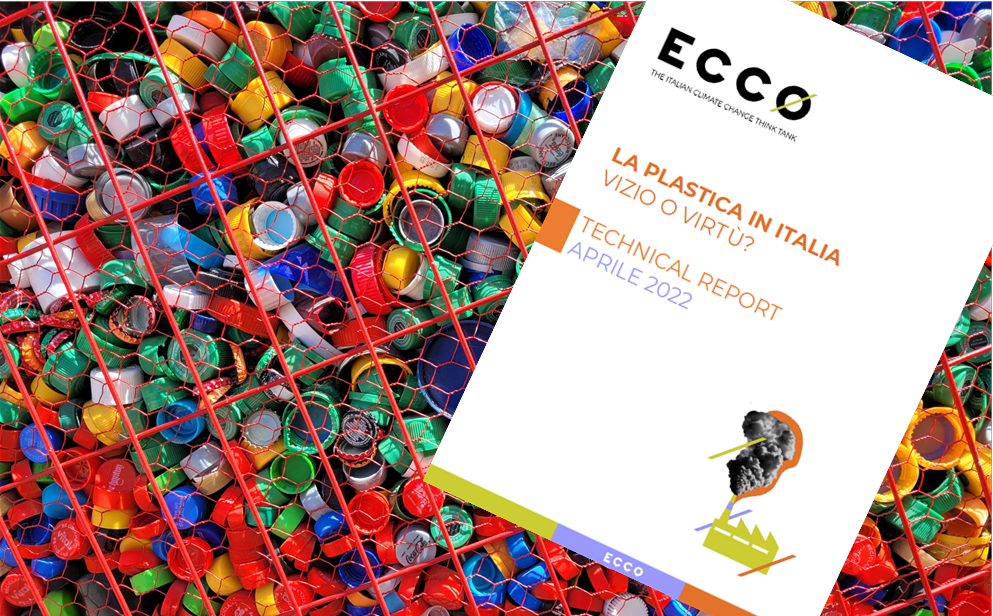The plastics sector is a clear example of the importance of aligning industrial processes with climate challenges. This objective will require regulatory solutions to reduce plastic use and increase reuse and recycling, precise regulations on disposable packaging and a deposit regulation in line with European objectives. It is in this perspective that the transition towards the use of new technologies should be seen, such as bioplastics of plant origin, for which the markets for plastics of fossil origin, mainly imported, harmful to the environment and climate, must be progressively opened.
In this report, written by ECCO in collaboration with Greenpeace, SPRING – the Italian cluster of Circular Bioeconomy and the Universities of Padua and Palermo, we analyze critical issues, solutions and future scenarios to promote a decarbonization of the plastics supply chain that will allow the sector to remain competitive and, at the same time, remain aligned with the 2050 climate neutrality goals.
Download the report here.
Plastic is characterized by a wide variety of properties that have made it indispensable in many applications. Italy is the second largest consumer of plastic in Europe: in 2020, 5.9 million tons of fossil polymers were consumed, corresponding to almost 100 kg per person.
In Europe, 99% of virgin plastics are produced using oil and natural gas as raw materials and fossil fuels are also used to generate the heat needed during the production process. This results in approximately 1.2 kg of CO2 being emitted into the atmosphere for every kg of plastic in the production phase alone. If we also look at the CO2 emissions related to the extraction and refining of fossil fuels, the production of 1 kg of plastic results in a total of about 1.7 kg of direct CO2 emissions.
42% of the plastic consumed in our country is used in the packaging and disposable sector, 12% in the construction industry and 7% in the automotive sector. Just over 30% of plastic waste in Italy is sent for recycling and bioplastics account for almost 6% of the market (in terms of production). For the plastics sector to continue to play a key role in Italy’s manufacturing fabric, while contributing to environmental and climate goals, it is essential that there is an industry policy that provides effective policies. At the moment, the political vision for this industrial sector is insufficient and this void must be filled as soon as possible to give a clear direction to the players in the sector. The large use of packaging and the lack of legislative proposals in the disposable supply chain are two examples of how there is a risk of not orienting Italian industry towards economic activities compatible with long-term climate objectives.
Solutions will need to be built on three ‘pillar objectives’:
- Reducing plastic consumption;
- Increased recycling and reuse rates;
- Use of bioplastics.
The report also develops two scenarios to 2050 (current policies and best case) regarding plastic consumption in Italy and the CO2 emissions associated with that consumption. The first scenario assumes that plastic consumption increases by 5% every six years. In the 2050 best case scenario, it is assumed that, thanks to the elimination of overpackaging and the reduction of single-use plastic packaging consumption and of plastic consumption in other sectors, the growth trend in consumption will be reversed, reaching 3.8 Mt in 2050.
As for the emissions associated with this plastic consumption. In the Current Policies Scenario, it is assumed that still more than half of the plastic placed on the Italian market is fossil and the remaining plastic is from recycled or biobased material. Considering end-of-life, it is assumed that 70% of post-consumer plastic waste is recycled; the rest of the waste is destined for waste-to-energy or industrial composting. This scenario results in a 9% reduction in emissions compared to 2020.
The 2050 Best Case Scenario assumes that no more fossil fuel-based plastics are placed on the Italian market, but only recycled and biobased plastics. Accepting European calls for the elimination of landfilling and the reduction of CO2 emissions through incineration, it is assumed that more than 90% of plastic waste is recycled, thanks to major improvements in the collection, sorting and recycling of plastics. In this scenario, a 98% reduction in emissions from 2020 is achieved.
The 2050 Best Case Scenario is a very ambitious scenario. To achieve these results it will be necessary to put in place various policy tools that will first of all allow to reverse the trend of growth in consumption and, at the same time, allow recycled and biobased plastics to occupy increasingly large market segments.
Download the report here.
Photo by Killari Hotaru on Unsplash






